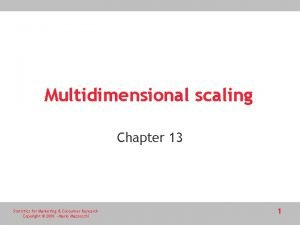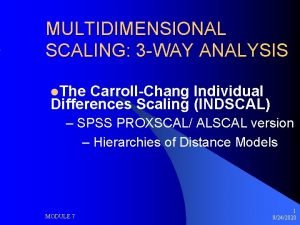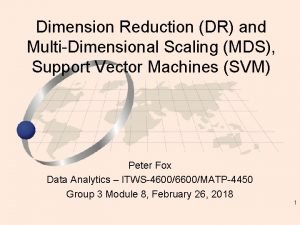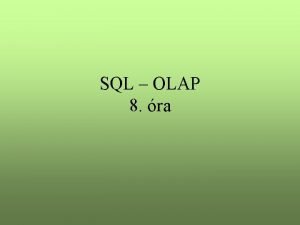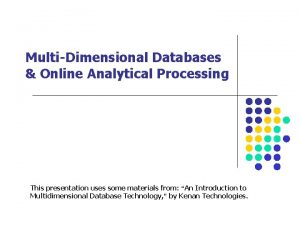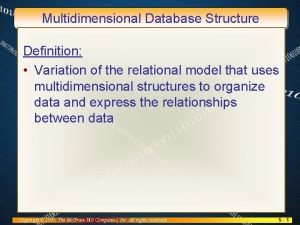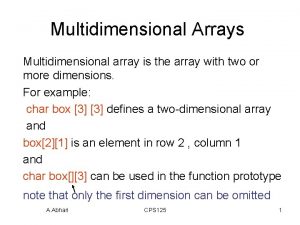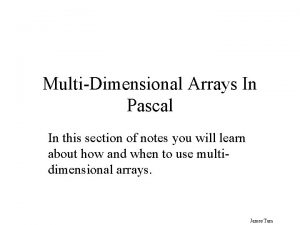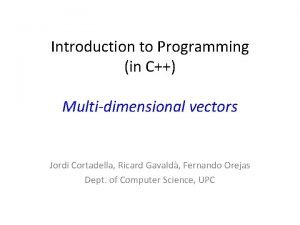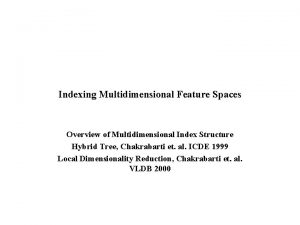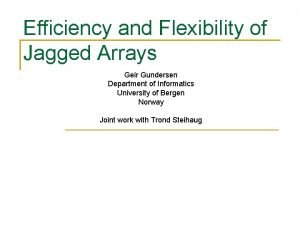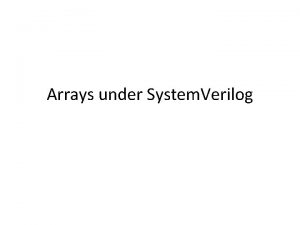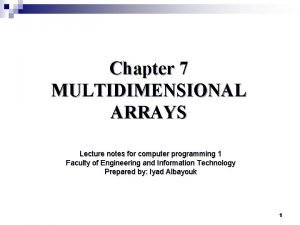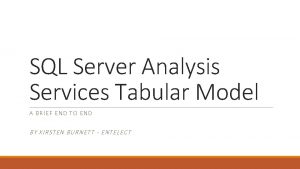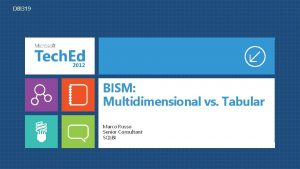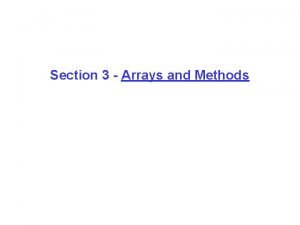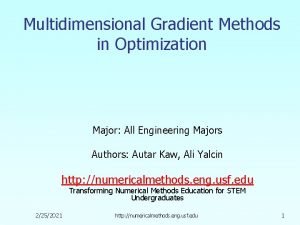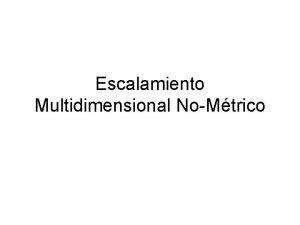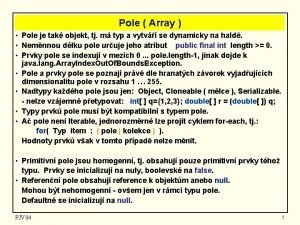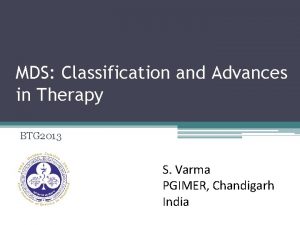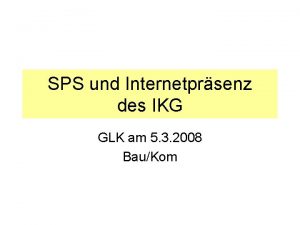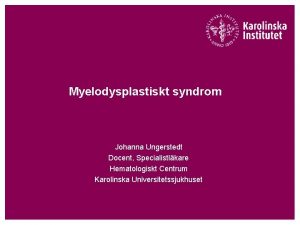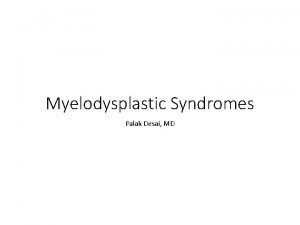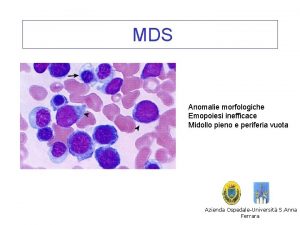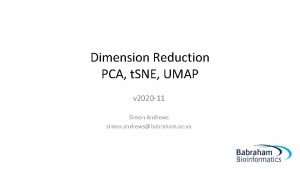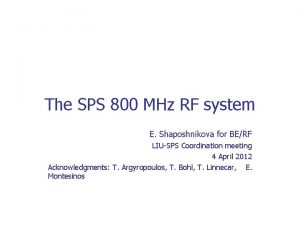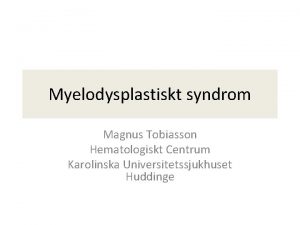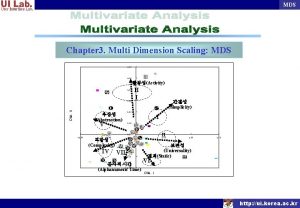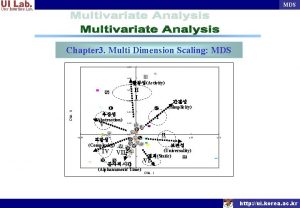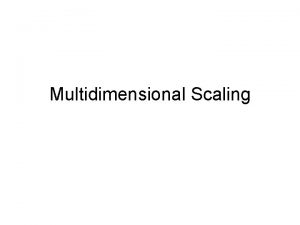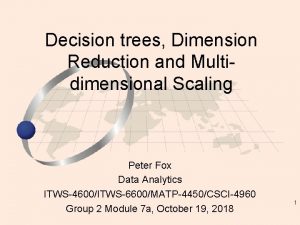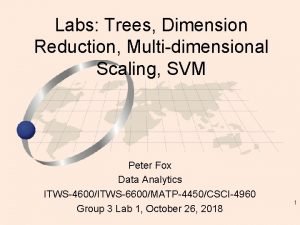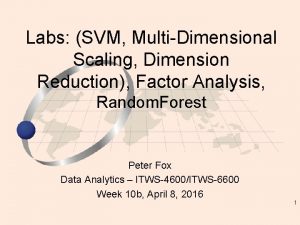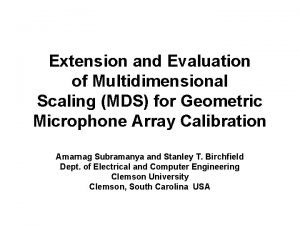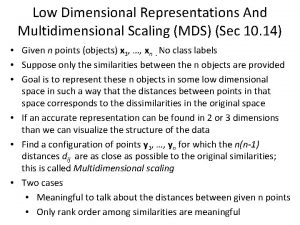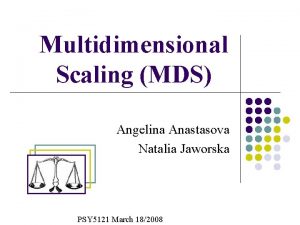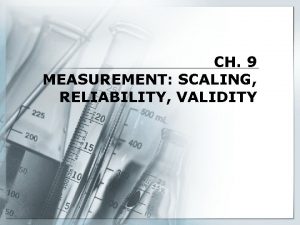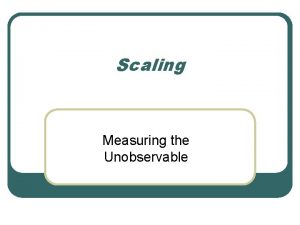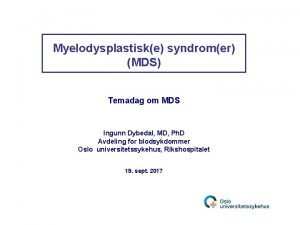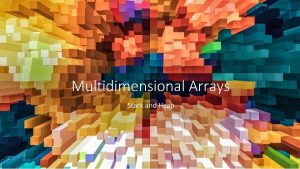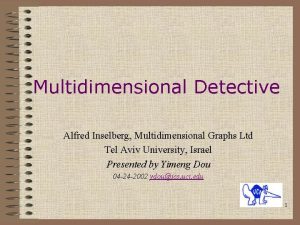Dimension Reduction DR and MultiDimensional Scaling MDS Support










![Distances between Australian cities row. names(dist. au) <- dist. au[, 1] dist. au <- Distances between Australian cities row. names(dist. au) <- dist. au[, 1] dist. au <-](https://slidetodoc.com/presentation_image_h/316af30fad7d996cf2e40b147d467e42/image-11.jpg)





















































- Slides: 64

Dimension Reduction (DR) and Multi-Dimensional Scaling (MDS), Support Vector Machines (SVM) Peter Fox Data Analytics – ITWS-4600/6600/MATP-4450 Group 3 Module 8, February 26, 2018 1

Dimension reduction. . • Principle component analysis (PCA) and meta. PCA (in R) • Singular Value Decomposition • Feature selection, reduction • Built into a lot of clustering • Why? – Curse of dimensionality – or – some subset of the data should not be used as it adds noise • What is it? – Various methods to reach an optimal subset 2

Simple example 3

More dimensions 4

Feature selection • The goodness of a feature/feature subset is dependent on measures • Various measures – Information measures – Distance measures – Dependence measures – Consistency measures – Accuracy measures 5

Multidimensional Scaling • Visual representation ~ 2 -D plot - patterns of proximity in a lower dimensional space • "Similar" to PCA/DR but uses dissimilarity as input > dissimilarity matrix – An MDS algorithm aims to place each object in Ndimensional space such that the between-object distances are preserved as well as possible. – Each object is then assigned coordinates in each of the N dimensions. – The number of dimensions of an MDS plot N can exceed 2 and is specified a priori. – Choosing N=2 optimizes the object locations for a twodimensional scatterplot 6

Four types of MDS • Classical multidimensional scaling – Also known as Principal Coordinates Analysis, Torgerson Scaling or Torgerson–Gower scaling. Takes an input matrix giving dissimilarities between pairs of items and outputs a coordinate matrix whose configuration minimizes a loss function called strain. • Metric multidimensional scaling – A superset of classical MDS that generalizes the optimization procedure to a variety of loss functions and input matrices of known distances with weights and so on. A useful loss function in this context is called stress, which is often minimized using a procedure called stress majorization. 7

Four types of MDS ctd • Non-metric multidimensional scaling – In contrast to metric MDS, non-metric MDS finds both a non-parametric monotonic relationship between the dissimilarities in the item-item matrix and the Euclidean distances between items, and the location of each item in the low-dimensional space. The relationship is typically found using isotonic regression. • Generalized multidimensional scaling – An extension of metric multidimensional scaling, in which the target space is an arbitrary smooth non-Euclidean space. In cases where the dissimilarities are distances on a surface and the target space is another surface, GMDS allows finding the minimum-distortion embedding of one surface into another. 8

In R function (library) • cmdscale() (stats) • smacof. Sym() (smacof) • wcmdscale() (vegan) • pco() (ecodist) • pco() (labdsv) • pcoa() (ape) • Only stats is loaded by default, and the rest are not installed by default 9

cmdscale() cmdscale(d, k = 2, eig = FALSE, add = FALSE, x. ret = FALSE) d - a distance structure such as that returned by dist or a full symmetric matrix containing the dissimilarities. k - the maximum dimension of the space which the data are to be represented in; must be in {1, 2, …, n-1}. eig - indicates whether eigenvalues should be returned. add - logical indicating if an additive constant c* should be computed, and added to the non-diagonal dissimilarities such that the modified dissimilarities are Euclidean. x. ret - indicates whether the doubly centred symmetric distance matrix should be returned. 10
![Distances between Australian cities row namesdist au dist au 1 dist au Distances between Australian cities row. names(dist. au) <- dist. au[, 1] dist. au <-](https://slidetodoc.com/presentation_image_h/316af30fad7d996cf2e40b147d467e42/image-11.jpg)
Distances between Australian cities row. names(dist. au) <- dist. au[, 1] dist. au <- dist. au[, -1] dist. au ## A AS B D H M P S ## A 0 1328 1600 2616 1161 653 2130 1161 ## AS 1328 0 1962 1289 2463 1889 1991 2026 ## B 1600 1962 0 2846 1788 1374 3604 732 ## D 2616 1289 2846 0 3734 3146 2652 3146 ## H 1161 2463 1788 3734 0 598 3008 1057 ## M 653 1889 1374 3146 598 0 2720 713 ## P 2130 1991 3604 2652 3008 2720 0 3288 ## S 1161 2026 732 3146 1057 713 3288 0 11

Distances between Australian cities fit <- cmdscale(dist. au, eig = TRUE, k = 2) x <- fit$points[, 1] y <- fit$points[, 2] plot(x, y, pch = 19, xlim = range(x) + c(0, 600)) city. names <- c("Adelaide", "Alice Springs", "Brisbane", "Darwin", "Hobart", "Melbourne", "Perth", "Sydney") text(x, y, pos = 4, labels = city. names) 12

13

R – many ways (of course) library(igraph) g <- graph. full(nrow(dist. au)) V(g)$label <- city. names layout <- layout. mds(g, dist = as. matrix(dist. au)) plot(g, layout = layout, vertex. size = 3) 14

15

Support Vector Machine • Conceptual theory, formulae… see Reading! • SVM - general (nonlinear) classification, regression and outlier detection with an intuitive model representation • Hyperplanes separate the classification spaces (can be multi-dimensional) • Kernel functions can play a key role 16

Schematically 17 http: //en. wikipedia. org/wiki/File: Svm_separating_hyperplanes_(SVG). svg

Schematically Support Vectors 18 b=bias term, b=0 (unbiased) http: //en. wikipedia. org/wiki/File: Svm_max_sep_hyperplane_with_margin. png

Construction • Construct an optimization objective function that is inherently subject to some constraints – Like minimizing least square error (quadratic) • Most important: the classifier gets the points right by “at least” the margin • Support Vectors can then be defined as those points in the dataset that have "non zero” Lagrange multipliers*. – make a classification on a new point by using only the support vectors – why? 19

Support vectors • Support the “plane” 20

What about the “machine” part • Ignore it – somewhat leftover from the “machine learning” era – It is trained and then – Classifies 21

No clear separation = no hyperplane? Soft-margins… Non-linearity or transformation 22

Feature space Mapping (transformation) using a function, i. e. a kernel Ø goal is – linear separability 23

Kernels or “non-linearity”… http: //www. statsoft. com/Textbook/Support-Vector-Machines the kernel function, represents a dot product of input data points mapped into the higher dimensional feature space by transformation phi + note presence of “gamma” parameter 24

Best Linear Separator: Supporting Plane Method Maximize distance Between two paral supporting planes Distance = “Margin” =

Soft Margin SVM Just add non-negative error vector z.

Method 2: Find Closest Points in Convex Hulls d c

Plane Bisects Closest Points d c

Find using quadratic program Many existing and new QP solvers.

Dual of Closest Points Method is Support Plane Method Solution only depends on support vectors:

One bad example? Convex Hulls Intersect! Same argument won’t work.

Don’t trust a single point! Each point must depend on at least two actual data points.

Depend on >= two points Each point must depend on at least two actual data points.

Depend on >= two points Each point must depend on at least two actual data points.

Depend on >= two points Each point must depend on at least two actual data points.

Depend on >= two points Each point must depend on at least two actual data points.

Final Reduced/Robust Set Each point must depend on at least two actual data points. Called Reduced Convex Hull

Reduced Convex Hulls Don’t Intersect Reduce by adding upper bound D

Find Closest Points Then Bisect No change except for D. D determines number of Support Vectors.

Dual of Closest Points Method is Soft Margin Method Solution only depends on support vectors:

What will linear SVM do?

Linear SVM Fails

High Dimensional Mapping trick http: //www. slideshare. net/ankitksh arma/svm-37753690


Nonlinear Classification: Map to higher dimensional space IDEA: Map each point to higher dimensional feature space and construct linear discriminant in the higher dimensional space. Dual SVM becomes:

Kernel Calculates Inner Product

Final Classification via Kernels The Dual SVM becomes:

Generalized Inner Product By Hilbert-Schmidt Kernels (Courant and Hilbert 1953) for certain and K, e. g. Also kernels for nonvector data like strings, histograms, dna, …

Final SVM Algorithm • Solve Dual SVM QP • Recover primal variable b • Classify new x Solution only depends on support vectors:

S 5: Recall linear solution

RBF results on Sample Data

Have to pick parameters Effect of C

Effect of RBF parameter

General Kernel methodology • • • Pick a learning task Start with linear function and data Define loss function Define regularization Formulate optimization problem in dual space/inner product space • Construct an appropriate kernel • Solve problem in dual space

kernlab, svmpath and kla. R • http: //aquarius. tw. rpi. edu/html/DA/v 15 i 09. pdf Karatzoglou et al. 2006 • Work through the examples (lab) – Familiar datasets and samples procedures from 4 libraries (these are the most used) – kernlab – e 1071 – svmpath – kla. R 55

Application of SVM • Classification, outlier, regression… • Can produce labels or probabilities (and when used with tree partitioning can produce decision values) • Different minimizations functions subject to different constraints (Lagrange multipliers) See Karatzoglou et al. 2006 • Observe the effect of changing the C parameter and the kernel 56

Types of SVM (names) • Classification SVM Type 1 (also known as CSVM classification) • Classification SVM Type 2 (also known as nu. SVM classification) • Regression SVM Type 1 (also known as epsilon-SVM regression) • Regression SVM Type 2 (also known as nu. SVM regression) 57

More kernels 58 Karatzoglou et al. 2006

Timing 59 Karatzoglou et al. 2006

Library capabilities Karatzoglou et al. 2006 60

Extensions • Many Inference Tasks – – – – Regression One-class Classification, novelty detection Ranking Clustering Multi-Task Learning Kernels Canonical Correlation Analysis Principal Component Analysis

Algorithms Types: • General Purpose solvers – CPLEX by ILOG – Matlab optimization toolkit • Special purpose solvers exploit structure of the problem – Best linear SVM take time linear in the number of training data points. – Best kernel SVM solvers take time quadratic in the number of training data points. • Good news since convex, algorithm doesn’t really matter as long as solvable.

Hallelujah! • Generalization theory and practice meet • General methodology for many types of inference problems • Same Program + New Kernel = New method • No problems with local minima • Few model parameters. Avoids overfitting • Robust optimization methods. • Applicable to non-vector problems. • Easy to use and tune • Successful Applications BUT…

Catches • Will SVMs beat my best hand-tuned method Z on problem X? • Do SVMs scale to massive datasets? • How to chose C and Kernel? • How to transform data? • How to incorporate domain knowledge? • How to interpret results? • Are linear methods enough?
 Multidimensional scaling marketing
Multidimensional scaling marketing Proxscal vs alscal
Proxscal vs alscal Multidimensional scaling - ppt
Multidimensional scaling - ppt Size reduction
Size reduction Mining complex types of data
Mining complex types of data Major and minor details
Major and minor details Turing macine
Turing macine Multidimensional expressions
Multidimensional expressions Multidimensional model of leadership
Multidimensional model of leadership Mddb database
Mddb database Database structure definition
Database structure definition Multidimensional array
Multidimensional array Arrays in pascal examples
Arrays in pascal examples Multidimensional space in data mining
Multidimensional space in data mining Fountas and pinnell oral reading rate
Fountas and pinnell oral reading rate Distance matrix example
Distance matrix example Multidimensional indexing
Multidimensional indexing Mdm marketing
Mdm marketing Jagged array vs multidimensional array
Jagged array vs multidimensional array Multidimensional turing machine
Multidimensional turing machine Verilog array indexing
Verilog array indexing Multidimensional models of psychopathology
Multidimensional models of psychopathology Multidimensional model of sport leadership
Multidimensional model of sport leadership Multidimensional or hypervolume niche
Multidimensional or hypervolume niche Multidimensional calm test
Multidimensional calm test Processing multidimensional array
Processing multidimensional array Ssas tabular vs multidimensional performance
Ssas tabular vs multidimensional performance What is multidimensional talent
What is multidimensional talent One-dimensional vs multidimensional models
One-dimensional vs multidimensional models Brioquery
Brioquery Ssas multidimensional vs tabular
Ssas multidimensional vs tabular Contoh array 2 dimensi python
Contoh array 2 dimensi python C# initialize multidimensional array
C# initialize multidimensional array Multidimensional gradient
Multidimensional gradient Escalamiento multidimensional no métrico
Escalamiento multidimensional no métrico Multidimensional array java
Multidimensional array java Multidimensional expressions
Multidimensional expressions Multidimensional reporting
Multidimensional reporting Multidimensional approach to psychopathology
Multidimensional approach to psychopathology Dr inanch mehmet
Dr inanch mehmet Nota tecnica 02/2016 snas/mds
Nota tecnica 02/2016 snas/mds Hypothytical
Hypothytical Metoda dobrego startu bogdanowicz
Metoda dobrego startu bogdanowicz Fab classification of mds
Fab classification of mds Assistante sociale chelles
Assistante sociale chelles Ge mds transnet 900 radio
Ge mds transnet 900 radio Mds sistemas parcelas pagas
Mds sistemas parcelas pagas Cisco mds
Cisco mds Mds orbit
Mds orbit Ats mds
Ats mds Adl charting cheat sheet
Adl charting cheat sheet Avatars mds
Avatars mds Schulportal mds
Schulportal mds Ferritin infektion
Ferritin infektion Mds business rules examples
Mds business rules examples Ouvidoria previdenciária
Ouvidoria previdenciária Palak desai md
Palak desai md Mds
Mds Mds
Mds Umap vs tsne
Umap vs tsne Mds da800
Mds da800 Empathie étymologie
Empathie étymologie Magnus tobiasson
Magnus tobiasson Profisee maestro
Profisee maestro Hypoplastisk mds
Hypoplastisk mds
